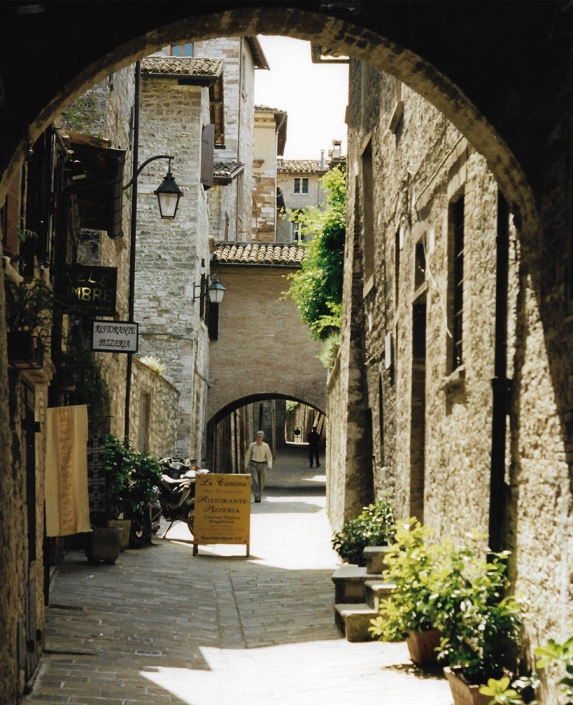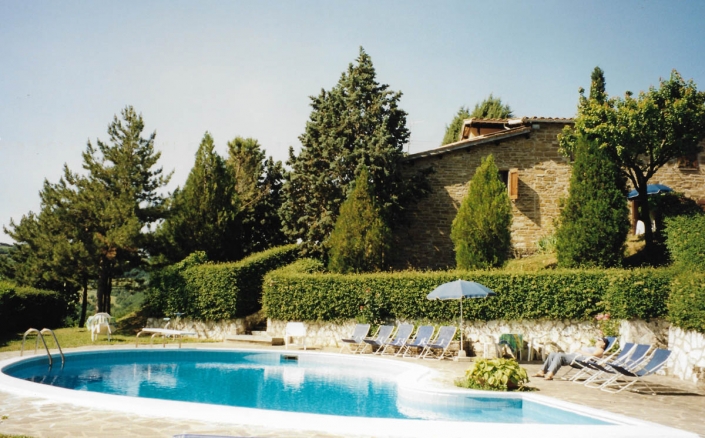Each May, the Umbrian town of Gubbio lays on a spectacle like no other
When the cheer went up, the noise almost knocked me flying from my wall-top perch.
By the ear-shattering roar from the crowd, you’d have thought the local football team had just scored the winning goal against FC Milan.
Before the choral boom erupted, the atmosphere was electric. An edgy air of anticipation and excitement ran through the heart of the medieval masterpiece that is Gubbio.
We were up with the dawn chorus to join the throng and, once in the midst of the surging, colourful and frenzied mass of celebrants who had gathered in the streets, there were occasional flutters of mild panic and an urge to identify an escape route.
Despite the fact that the day has just begun, every possible vantage point was occupied and there was little chance of squeezing another human being into the narrow cobbled lanes and alleyways which criss-cross the heart of the old town.
In windows opening onto tiny, precarious balconies, faces filled with wonder and delight stretched and strained to be first to spot the unfolding action.
On the day of the Corsa Dei Ceri, said to celebrate the town’s patron saint, Ubaldo, a festival little known outside of Italy, but which ranks second only to Siena’s famous Palio in its exuberance and bizarre pageantry.
The nine hundred-year-old ceremony starts off with an early morning Mass and procession in which the big wooden Ceri are paraded through the streets.
The origins of the event are widely debated. Most believe the feast dates back to 1155 when Ubaldo talked Barbarossa out of flattening Gubbio.
The church has certainly hijacked the festival these days even though some scholars maintain the celebration is obviously steeped in pagan symbolism and a re-enactment of an ancient pre-Christian pagan festival in honour of the god Cerere (hence the name “Ceri”) for the arrival of Spring.
Mighty
Judging by the cheer that goes up when the three mighty constructions each weighing 300 kg and tethered to big stretchers, are raised to stand proud above the gathering, there’s certainly something more than Christian jubilation in the air.
They come from all over Umbria and much further afield, arriving many hours before dawn, just to get a front row position.
The night before, tradition has it that the whole town flips into party mode as soon as the powerful striking of the Campanone (big bell) rings out. It’s quite a night as laughter fills the air with
crowds from cafes, bars and restaurants spilling out on to the streets to mingle with those who have emerged from their homes to promenade, sing and dance. The merriment carries on for hours and only dies down temporarily in the wee small hours, some revellers still roaming around, intent on partying until dawn.
Those who stay up without any sleep join the drummers who at first light march through the streets to waken the protagonists.
At 6am, the big bell rings out again to rouse folks from their snatch of slumber. Three hours later, three little figures of the saints which will be placed on top of the huge wooden Ceri are paraded through the streets.
After a traditional breakfast of salt cod, the raising of the Ceri (possibly the most intense and fascinating moments of the entire day) a frenzy of activity explodes as each competing group, urged on by their fanatical supporters, set off to reach the summit of Mount Ingino.
The Ceri, resembling giant Christmas crackers, with statues of St Ubaldo, St George and St Anthony on top, are carried from the historic centre to the Basilica of St Ubaldo on the top of the mountain in an extraordinary race which starts in the morning and continues into the afternoon.
Cable car
It is a truly fantastic spectacle, held on May 15 each year, for those who manage to get close to the action. Those who suffer from claustrophobia or fear of being crushed, can escape the mayhem by taking the Colle Eletto cable ride in the open cages big enough to carry just two people at a time which take six minutes to climb to the top of Mount Ingino from the station in Via San Gerolamo, soaring at first over the red-tiled rooftops, then up across the pine woods which cover the slopes.
For the remaining 364 days of the year, of course, Gubbio has much else to celebrate, including as rich a past as any other towns in Italy. Visitors can enjoy fourteen churches, a cathedral, Roman amphitheatre and mausoleum, as well as five palaces It’s also a gateway to the mountains and the Marche region, rich in wildlife. If the duration of your stay permits, and car hire is included, try to time your visit to catch another very different spectacle – the outdoor collectors’ fleamarket in Pissignana to the south near Todi – where locals, including farmers selling obsolete and unwated tools and knick-knacks, join professional traders to lay on a wonderful street event on the first Sunday of each month.
* There are stunning views from the aptly named Villa Panoramica high up on a hillside on the other side of the valley from Gubbio, which can be rented online. The property, surrounded by scented pine woods, has a superb pool.






